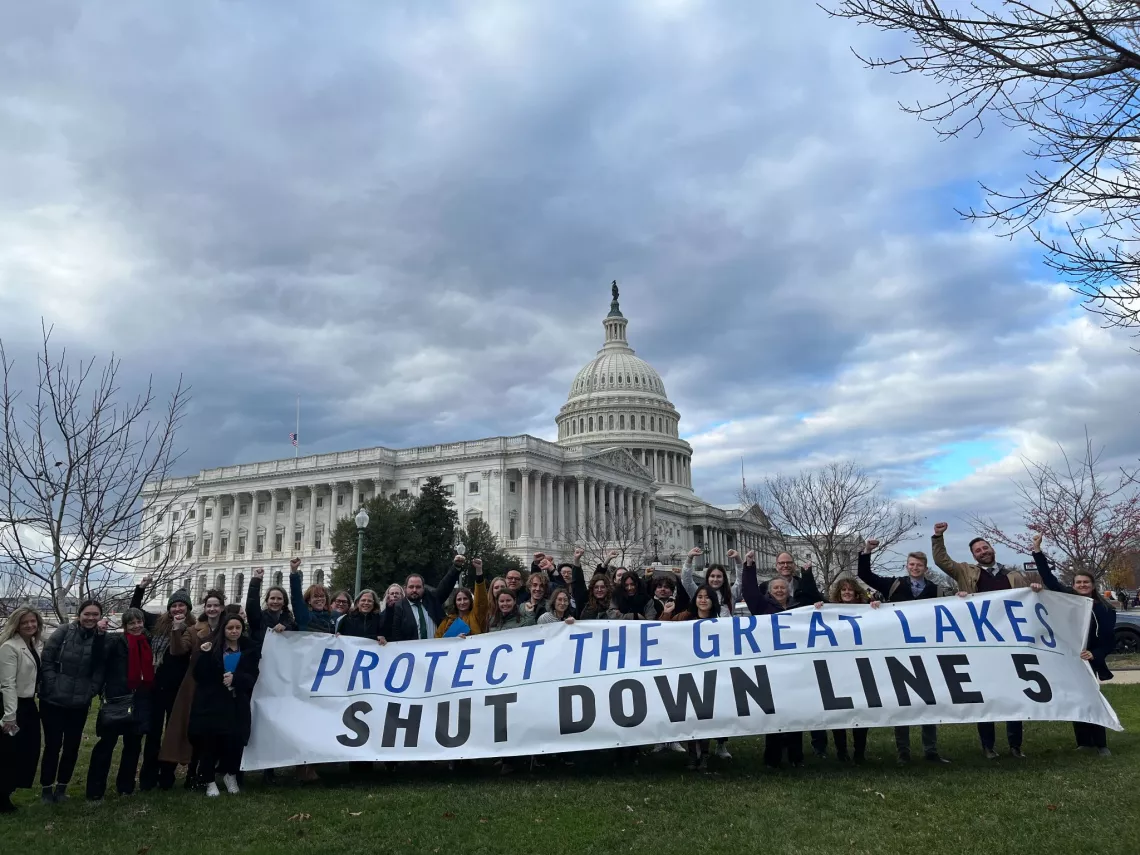Candidate Engagement Training
Thursday, March 14, at 12 PM and 6 PM
REGISTER for 12 PM REGISTER for 6 PM
Bad River, chronicles the Wisconsin-based Bad River Band and the Band’s ongoing fight for sovereignty, which unfolds in a groundbreaking way through a series of shocking revelations, devastating losses, and a powerful legacy of defiance and resilience. Learn more and find tickets on the documentary's official website.
Overview
Enbridge’s Line 5 pipeline transports 22 million gallons of crude oil and natural gas liquids across 645 miles of countryside every day. This aging oil pipeline violates tribal treaty rights and poses catastrophic risks to the drinking water for 40 million people and one-fifth of the world's surface freshwater. Governor Whitmer of Michigan ordered Enbridge to shut down Line 5 in May 2021. Yet, Enbridge continues to operate Line 5 illegally in spite of Governor Whitmer's shut down order.
A History of Line 5
The Enbridge Line 5 pipeline was constructed in 1953 and built to last 50 years. The pipeline runs from Superior, Wisconsin to Sarnia, Ontario. The 30-inch pipeline splits into two separate 20-inch lines and runs under the Straits of Mackinac, a 4.5 mile wide stretch of water in Michigan, which separates Lake Michigan from Lake Huron.
In 2013, University of Michigan experts identified the Straits of Mackinac as the worst place in the Great Lakes for an oil spill. The current in the Straits changes direction 180 degrees on an average of every 1.5 days, and the peak flow of water through the Straits is over 10 times the flow of water over Niagara Falls. This is also an important indigenous cultural resource and one of the busiest shipping lanes in the Great Lakes.
Line 5 has spilled 33 times and at least 1.1 million gallons along its length since 1968. Yet, every day nearly 23 million gallons of oil flow through these aging pipelines located in the heart of the Great Lakes, threatening one of the most ecologically sensitive areas in the world. The Great Lakes are home to 21 percent of the fresh surface water on Earth, providing 40 million people with clean drinking water and supporting a thriving economy for Michigan families.
University of Michigan experts identify the Straits of Mackinac as the worst place in the Great Lakes for an oil spill, with over 700 miles of shoreline at risk if Line 5 ruptures.
In 2018, an anchor struck Line 5 in the Straits of Mackinac, causing three large gouges in the pipeline. Enbridge control systems didn’t detect the anchor strike, and despite not having video evidence of the pipeline’s condition for over two weeks, Enbridge never shut the pipeline down. Just two years later, another anchor struck Line 5, damaging structural support – likely caused by an Enbridge contractor. A judge ordered a temporary shutdown until the damage could be assessed.
In November 2021, Governor Gretchen Whitmer and Department of Natural Resources (DNR) Director Dan Eichinger revoked the 1953 easement which allowed Enbridge to operate their Line 5 dual pipelines under the Straits of Mackinac. The state revoked the easement for violations of the public trust doctrine and the unreasonable risk Line 5 poses to the Great Lakes.
Enbridge was given 180 days to comply with the shutdown order. The deadline came and went, yet Enbridge continues to operate the pipeline today, violating the law. Court battles have ensued, and as each day passes, Line 5 remains a ticking time bomb in the Great Lakes.
The Great Lakes Tunnel & Environmental Impact Statement (EIS)
Enbridge wants to relocate a portion of Line 5 into a new tunnel under the Straits of Mackinac. However, a tunnel is not a safe solution. Experts have warned there is a risk of explosion, based on a geotechnical investigation. This could be deadly to construction workers inside the tunnel, not to mention an explosion could have catastrophic consequences for the existing Line 5 pipeline, the Straits of Mackinac, and the treasured Great Lakes. Additionally, building new fossil fuel infrastructure is counterproductive to the policies in place to combat the climate crisis.
Before Enbridge can move forward with construction on the Great Lakes Tunnel, they must acquire permits. In 2021, the U.S. Army Corps of Engineers (USACE) announced they will do an Environmental Impact Statement (EIS) on the proposed Line 5 tunnel before arriving at a permitting decision.
This environmental review process is part of the National Environmental Policy Act (NEPA), which was signed into law in 1970. NEPA requires federal agencies to consider environmental effects of their proposed actions prior to making decisions (such as permitting). This process also gives citizens the opportunity to get involved and voice their opinion. If you’d like to learn more about NEPA and the EIS process, click here to view the Citizen’s Guide to NEPA.
The EIS process came to an end in late October, 2022. Stay up to date on Line 5 news by checking out our partner organization, Oil & Water Don't Mix:
Enbridge and the Kalamazoo River Disaster
The July 25, 2010 Kalamazoo River Disaster caused by Enbridge Energy's broken pipeline was one of the biggest inland oil spills in U.S. history. At least 1 million gallons of diluted bitumen (dilbit), a heavy, thick crude oil that’s hard to pump without diluting it with hydrocarbons, spilled into the Talmadge Creek, near Marshall, and then flowed downstream to the Kalamazoo River. When the line broke, the sludge gradually sank to the bottom while the volatile hydrocarbons poisoned the air. Hundreds of homes and businesses had to be evacuated. About 150 families moved away permanently (2012 report - Inside Climate News). No one can say for sure how much sludge the dredging operation left at the bottom of Talmadge Creek and the Kalamazoo River.
It’s time to urge President Biden to act to protect the Great Lakes and climate from the Enbridge Line 5 oil pipeline.
